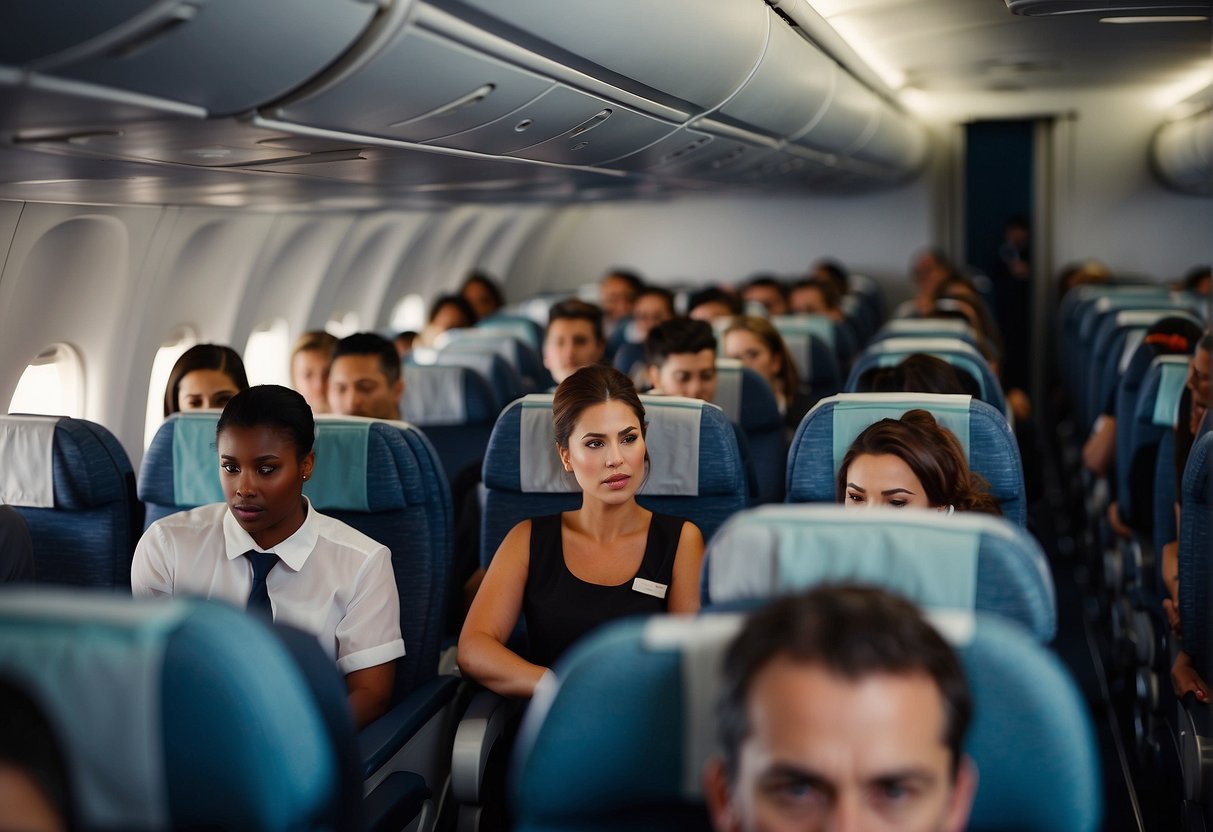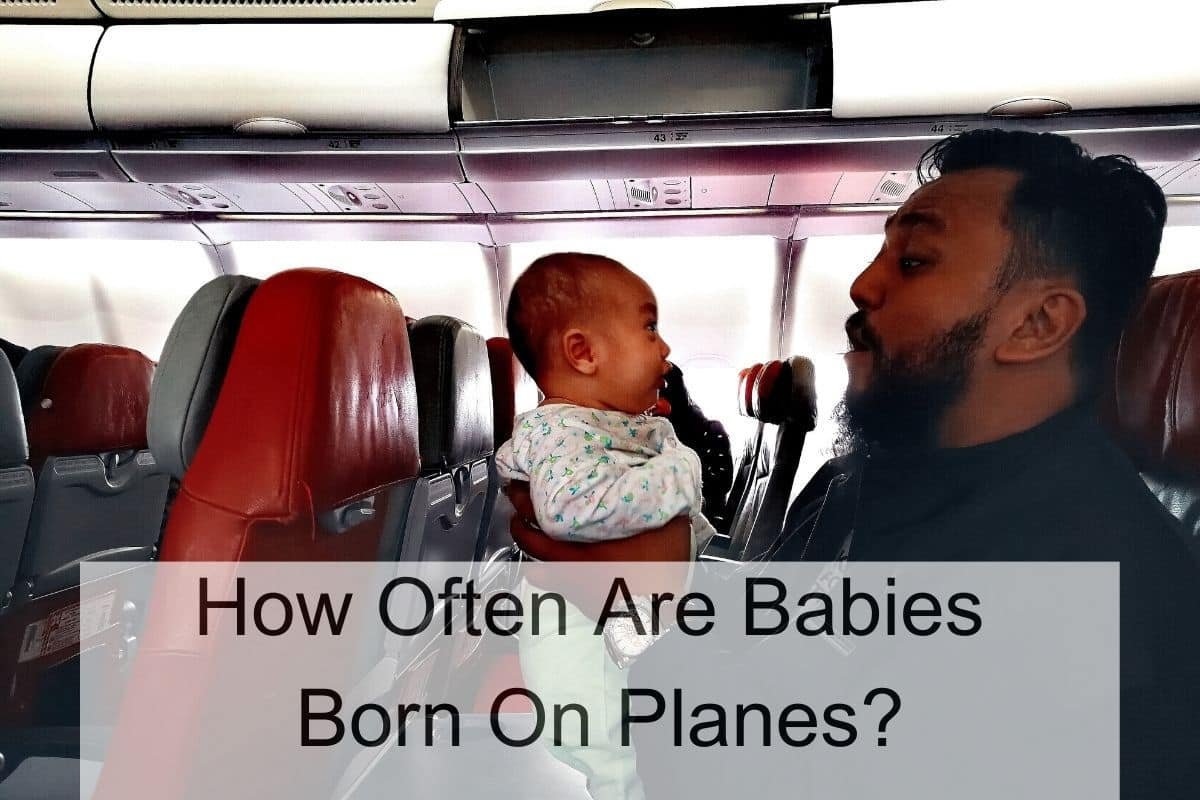I was recently on a flight and couldn’t help but wonder: how often are babies actually born on planes? It’s a question that many of us have probably asked ourselves at some point, especially when we see a pregnant woman boarding a flight.

As it turns out, the answer is quite rare. According to a study published by the International Society of Travel Medicine, only 74 infants have been born on commercial flights between 1929 and 2018, with 71 of them surviving delivery. This means that the likelihood of a baby being born on a plane is incredibly low, with only 0.00003% of all passengers giving birth mid-flight.
So, while it’s not impossible for a baby to be born on a plane, it’s certainly not something that happens often. The next time you’re on a flight and see a pregnant woman, rest assured that the chances of her giving birth in the air are very slim.
Prevalence of In-Flight Births

As a frequent traveler, I have always been curious about the prevalence of in-flight births. According to a 2020 study published by the International Society of Travel Medicine, there were 74 infants born on commercial flights between 1929 and 2018. Out of these, 71 infants survived delivery and were born healthy.
In-flight births are rare, occurring in approximately one in every 26 million passengers, per aviation medical support firm MedAire. Most airlines have regulations that prohibit pregnant women from flying during their third trimester, making in-flight births unusual. However, there have been cases where unexpected in-flight deliveries have occurred, especially in cases of premature babies.
It is interesting to note that the nationality of a baby born on a plane depends on the country where the aircraft is registered or the citizenship of the parents. For instance, if the aircraft is registered in Norway, the baby could be Norwegian. Alternatively, the baby could take the parent’s citizenship.
Airline Policies on Pregnant Passengers

As a frequent traveler, I know how important it is to be aware of airline policies on pregnant passengers. Here are the main policies you should be aware of:
Restrictions by Trimester
Most airlines allow pregnant women to fly up to 28 weeks into their pregnancy without any restrictions. After that, some airlines require a medical certificate or impose travel restrictions. For example, Virgin Australia requires a medical certificate dated within 10 days of departure date once you reach 28 weeks. For flights longer than four hours, travel is not permitted after 36 weeks of pregnancy (32 weeks if pregnant with multiples), or within 48 hours of normal vaginal delivery.
Medical Clearance Requirements
Some airlines require pregnant women to obtain medical clearance before flying. For example, Spirit Airlines “urges” pregnant passengers past 8 months (32 weeks) to get a doctor’s exam before flying to confirm it is safe to travel. However, no mention of a medical certificate being needed to fly.
Keep in mind that airline policies on pregnant passengers can vary widely, so it is always a good idea to check with your airline before booking your ticket. Additionally, it is always a good idea to consult with your doctor before flying while pregnant to ensure that it is safe for you and your baby.
Challenges of Delivering on a Plane

As a medical professional, I know that delivering a baby is a complex process that requires careful attention and resources. In a plane, however, there are several challenges that can make the delivery process even more complicated.
Limited Medical Resources
One of the primary challenges of delivering a baby on a plane is the limited availability of medical resources. While most commercial airlines carry basic medical kits, they are not equipped to handle a full-scale delivery. In the event of a mid-air birth, flight attendants and medical professionals on board will have to make do with what they have.
Cabin Pressure and Altitude Concerns
Another challenge of delivering a baby on a plane is the effect of cabin pressure and altitude on the mother and the newborn. At high altitudes, the air pressure is lower, which can cause a drop in oxygen levels. This can be particularly dangerous for newborns, who require a steady supply of oxygen to survive.
Legal Implications of Airspace Birth
Finally, there are legal implications to consider when a baby is born on a plane. The nationality of the baby can be determined by the country in which the aircraft is registered or by the parent’s citizenship. This can lead to complex legal issues, especially if the baby is born over international waters.
Historical Incidents of In-Flight Births

I have always been fascinated by the idea of babies being born on planes. It is a rare occurrence, but it happens. According to a 2020 study published by the International Society of Travel Medicine, 74 infants were born on commercial flights between 1929 and 2018. Of those, 71 survived delivery and three were stillborn.
One of the most famous cases of an in-flight birth occurred in 1990, when a woman gave birth on a Philippine Airlines flight from Manila to San Francisco. The baby was named “Sky” by the crew and passengers, and the airline awarded him free flights for life. This story has become somewhat of a legend in the aviation industry, and many airlines now offer similar rewards to babies born on their flights.
Another notable case occurred in 2017, when a woman gave birth on a Cebu Pacific flight from Dubai to Manila. The baby was delivered with the help of the flight attendants and a nurse who happened to be on board. The airline gave the baby a million “GetGo” points, which can be used for flights, hotels, and other travel-related expenses.
It’s important to note that the nationality of a baby born on a plane can be a bit complicated. In most cases, babies born in the air will be assigned the nationality of the airspace the airline is in at that moment. For example, babies born in US airspace will receive an American citizenship. If the country does not allow this, the baby will receive the parents’ nationality or the nationality of the country where the airline is registered.
Emergency Procedures and Training
As a flight attendant, I am trained to handle emergency situations, including childbirth scenarios. While rare, babies can be born on planes, and it is important that the crew is prepared to handle such situations. In this section, I will discuss crew training and emergency landing protocols for birth scenarios.
Crew Training for Birth Scenarios
All flight attendants undergo extensive training to handle emergency situations, including childbirth scenarios. During our training, we learn how to identify the signs of labor, assist with the delivery, and care for the newborn and mother. We are also trained to communicate with medical professionals on the ground who can provide guidance and assistance.
In addition to our initial training, flight attendants receive recurrent training to ensure that we are up-to-date on the latest procedures and protocols. This training includes simulations of childbirth scenarios, so we are prepared to handle any situation that may arise.
Emergency Landing Protocols
If a baby is born on a plane, the crew will follow specific protocols to ensure the safety of the newborn and mother. The captain will be notified immediately, and the flight will be diverted to the nearest airport with appropriate medical facilities. The crew will also communicate with medical professionals on the ground to coordinate medical care for the mother and newborn.
In some cases, an emergency landing may not be necessary if the mother and newborn are stable and do not require immediate medical attention. In these cases, the crew will take appropriate measures to care for the mother and newborn until the flight lands at its destination.
Nationality and Citizenship of Airborne Babies
As a frequent traveler, I have always been curious about the citizenship of babies born on planes. After conducting some research, I found that different countries follow varying principles of nationality for babies born on international flights.
Jus Soli and Jus Sanguinis Principles
According to Simple Flying, some countries grant citizenship based on the location of birth, known as jus soli. Other countries grant citizenship based on the citizenship of the parents, known as jus sanguinis. For example, the United States follows jus sanguinis, and a baby born to U.S. citizens on a plane would simply revert to the parents’ U.S. citizenship, as Mental Floss explains.
Complications with International Law
The citizenship of airborne babies can become complicated when international law is involved. HowStuffWorks notes that many countries, including the United States, grant citizenship to anyone born in their territorial airspace or waters, known as jus soli. However, other countries rely on jus sanguinis, or “right of the blood,” in these cases. If a baby is born over international waters or in regions without territorial rights, the citizenship of the baby can become more complicated.
In most cases, babies born in the air will be assigned the nationality of the airspace the airline is in at that moment, as EUclaim explains. If the country does not allow this, the baby will receive the parents’ nationality or the nationality of the country where the airline is registered.
Passenger Preparedness for Flight
As a frequent flyer, I know that unexpected situations can arise during a flight. One such situation could be the birth of a baby on board. While it is a rare occurrence, it is important for passengers to be prepared for such an event.
First and foremost, it is crucial to inform the flight attendants immediately if a passenger goes into labor. They are trained to handle such situations and will be able to provide the necessary assistance.
Passengers can also take some steps to prepare for such an event. For example, they can pack a small bag with essential items such as diapers, baby clothes, and formula. It is also a good idea to carry a copy of their medical records and insurance information.
In addition, passengers should be aware of the airline’s policies regarding pregnant women and infants. Some airlines require a doctor’s note for pregnant women after a certain point in their pregnancy, while others may not allow infants to travel until they are a certain age.
Statistics and Research on Air Travel During Pregnancy
As a writer researching the frequency of babies born on planes, I also looked into the safety of air travel during pregnancy. According to the American College of Obstetricians and Gynecologists (ACOG), occasional air travel during pregnancy is generally safe. Most commercial airlines allow pregnant women to fly up to 36 weeks of gestation. Some restrict pregnant women from international flights earlier in gestation and some require a doctor’s note after a certain point.
A study conducted in Israel among 284,069 women between 2000 to 2016 found that air travel during pregnancy was associated with negligible effects on gestational age and weight at birth. Another review article stated that air travel does not seem to be harmful to pregnancy and is generally considered safe. However, the data regarding the precise effect of air travel on thromboembolism, miscarriage, preterm labor rates, and pregnancy outcomes is limited.
It is important for pregnant women to consult with their healthcare provider before traveling by air to ensure that it is safe for them and their baby. Additionally, pregnant women should take necessary precautions such as wearing compression stockings, getting up to walk and stretch during the flight, and staying hydrated.

